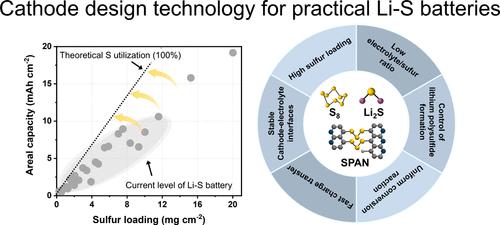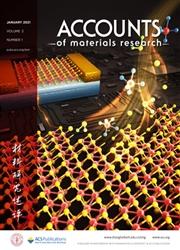Advanced Cathodes for Practical Lithium–Sulfur Batteries
IF 14
Q1 CHEMISTRY, MULTIDISCIPLINARY
引用次数: 0
Abstract
Sulfur, being lightweight, cost-effective, and offering a remarkably high lithium-ion storage capacity, has positioned lithium–sulfur (Li–S) batteries as promising candidates for applications that demand high energy density. These range from electric vehicles (EVs) to urban air mobility (UAM) systems. Despite this potential, Li–S batteries still face significant performance challenges, limiting their practical application. Chief among these challenges are the limited lifespan and low charge–discharge efficiency, predominantly caused by the dissolution of lithium polysulfide intermediate products formed during battery cycling in ether-based electrolytes. Moreover, sulfur and lithium sulfide, which constitute the active material in the cathode, are intrinsically insulating, complicating efforts to increase the active material content in the cathode and fabricate thick cathodes with high conductivity. These issues have long stood in the way of Li–S batteries achieving commercial viability. Overcoming these obstacles requires a multifaceted approach that focuses on modifications at the level of the cathode materials such as the active material, conductive agents, binders, and additives. This Account delves into these key challenges and presents a comprehensive overview of research strategies aimed at enhancing the performance of Li–S batteries with a particular focus on the sulfur cathode. First, the Account addresses practical challenges in Li–S batteries, such as the complex composition of the cathode, the low sulfur utilization efficiency, suboptimal electrolyte-to-sulfur ratios, and nonuniform sulfur conversion reactions. Strategies to overcome these barriers include the design of advanced cathode architectures that promote high sulfur utilization and an improved energy density. Modifications to the components of the cathode and the adjoining materials, such as the incorporation of conductive additives, help mitigate the insulating nature of sulfur.

实用锂硫电池的先进阴极
硫电池重量轻,具有成本效益,并提供非常高的锂离子存储容量,这使得锂硫电池(Li-S)成为高能量密度应用的有希望的候选者。这些系统包括电动汽车(ev)和城市空中交通(UAM)系统。尽管有这种潜力,锂硫电池仍然面临着重大的性能挑战,限制了它们的实际应用。这些挑战中最主要的是有限的寿命和低充放电效率,主要是由于电池循环过程中形成的多硫化锂中间产物在醚基电解质中的溶解造成的。此外,构成阴极活性物质的硫和硫化锂本质上是绝缘的,这使得增加阴极活性物质含量和制造具有高导电性的厚阴极的努力变得复杂。这些问题长期以来一直阻碍着锂电池实现商业可行性。克服这些障碍需要多方面的方法,重点是在正极材料的水平上进行修改,如活性材料、导电剂、粘合剂和添加剂。本报告深入研究了这些关键挑战,并全面概述了旨在提高锂硫电池性能的研究策略,特别关注硫阴极。首先,该报告解决了锂硫电池的实际挑战,如阴极的复杂组成、硫的低利用效率、次优的电解质硫比和不均匀的硫转化反应。克服这些障碍的策略包括设计先进的阴极结构,以提高硫的利用率和提高能量密度。对阴极和相邻材料的成分进行修改,例如加入导电添加剂,有助于减轻硫的绝缘性质。
本文章由计算机程序翻译,如有差异,请以英文原文为准。
求助全文
约1分钟内获得全文
求助全文

 求助内容:
求助内容: 应助结果提醒方式:
应助结果提醒方式:


